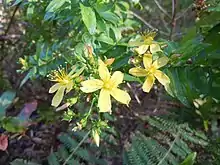| Hypericum glandulosum | |
|---|---|
 | |
| Scientific classification | |
| Kingdom: | Plantae |
| Clade: | Tracheophytes |
| Clade: | Angiosperms |
| Clade: | Eudicots |
| Clade: | Rosids |
| Order: | Malpighiales |
| Family: | Hypericaceae |
| Genus: | Hypericum |
| Subsection: | H. subsect. Aethiopica |
| Species: | H. glandulosum |
| Binomial name | |
| Hypericum glandulosum | |
Hypericum glandulosum is a perennial herb in the genus Hypericum, in the section Adenosepalum, subsect. Aethiopicum.[1]
Medicinal Uses of Hypericum glandulosum
According to a study done on the effects of Hypericum glandulosum on mice, the findings have revealed that the aerial component of Hypericum glandulosum in bloom has topical anti-inflammatory, analgesic activities, and anti-depressant properties, suggesting a potential for local medicinal uses in inflammatory illnesses.[2] Because of showing promise as a treatment for cancer, inflammation, bacterial and viral infections, and other conditions, hypericum glandulosum has gained popularity as a mainstream complementary medicine for treating depression.
References
- ↑ "Nomenclature | Hypericum online". hypericum.myspecies.info. Retrieved 2021-02-05.
- ↑ Sánchez-Mateo, C.C.; Bonkanka, C.X.; Prado, B.; Rabanal, R.M. (March 2005). "Antidepressant properties of some Hypericum canariense L. and Hypericum glandulosum Ait. extracts in the forced swimming test in mice". Journal of Ethnopharmacology. 97 (3): 541–547. doi:10.1016/j.jep.2004.12.019. ISSN 0378-8741.
This article is issued from Wikipedia. The text is licensed under Creative Commons - Attribution - Sharealike. Additional terms may apply for the media files.